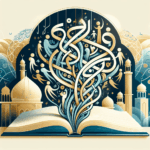Arabic Alphabet Lore: Myths and Legends
Welcome to the enchanting world of the Arabic alphabet! 🌟 Whether you’re a language enthusiast, a history buff, or just curious about the stories behind alphabets, you’re in the right place. In this blog post, we’ll explore the fascinating myths and legends surrounding the Arabic script. Let’s dive into this cultural tapestry and uncover tales that have been passed down through generations.
Table of Contents
- Introduction to the Arabic Alphabet
- Origin Myths: How the Alphabet Came to Be
- Mystical Tales and Symbolism
- Legends in Literature and Folklore
- Conclusion: The Legacy of the Alphabet
- FAQ
Introduction to the Arabic Alphabet
The Arabic alphabet is more than just a set of letters; it’s a gateway to rich cultural heritage and history. Consisting of 28 letters, the script is used by millions worldwide and has played a crucial role in preserving literature, science, and art. But beyond its practical use, the alphabet is steeped in myths and legends that add layers of intrigue to its existence.
Origin Myths: How the Alphabet Came to Be
One of the most captivating myths surrounding the Arabic alphabet is its divine origin. 📜 According to some legends, the script was revealed to the first prophet Adam by angels, making it a sacred gift to humanity. This myth highlights the spiritual significance of the alphabet in Islamic culture.
Another popular story suggests that the script was developed by the ancient Sumerians and eventually evolved into the form we recognize today. This tale underscores the interconnectedness of ancient civilizations and their contributions to modern language.
Mystical Tales and Symbolism
The Arabic alphabet is also believed to hold mystical powers. ✨ In some traditions, each letter is associated with specific energies and meanings. For instance, the letter „Alif“ is often linked to unity and the divine, while „Baa“ represents creation. These associations make the alphabet a tool for spiritual reflection and meditation.
Furthermore, the art of calligraphy, often referred to as „the geometry of the spirit,“ elevates these letters to an art form. Calligraphers are said to imbue their work with personal and spiritual significance, creating pieces that are both visually stunning and deeply meaningful.
Legends in Literature and Folklore
Arabic literature is rich with stories that feature the alphabet as a central theme. 📚 From ancient texts like „One Thousand and One Nights“ to modern novels, the letters often serve as symbols of knowledge, power, and mystery.
In folklore, tales abound of wise scholars and cunning wordsmiths who could manipulate the written word to achieve great feats. These stories emphasize the power of language and the profound respect for the written word in Arabic culture.
Conclusion: The Legacy of the Alphabet
The myths and legends of the Arabic alphabet offer a window into the cultural and spiritual dimensions of this ancient script. They remind us that language is not just a tool for communication, but a vessel for cultural identity and human expression. As you explore the stories and symbols of the Arabic alphabet, may you find inspiration and a deeper appreciation for its timeless legacy.
FAQ
Q: Is the Arabic alphabet difficult to learn?
A: While it may seem challenging initially due to its unique script and right-to-left reading direction, with practice and dedication, learning the Arabic alphabet can be an enjoyable and rewarding experience.
Q: Are there different variations of the Arabic alphabet?
A: Yes, the Arabic script has been adapted for several languages, including Persian, Urdu, and Pashto, each with slight variations in additional letters and pronunciation.
Q: How is Arabic calligraphy different from regular writing?
A: Arabic calligraphy is an art form that emphasizes the aesthetic beauty of the written word. It often involves intricate designs and careful attention to form and balance, transforming text into visual art.
Thank you for embarking on this journey through the myths and legends of the Arabic alphabet. If you have any more questions or stories to share, feel free to leave a comment below! 🌍✍️






